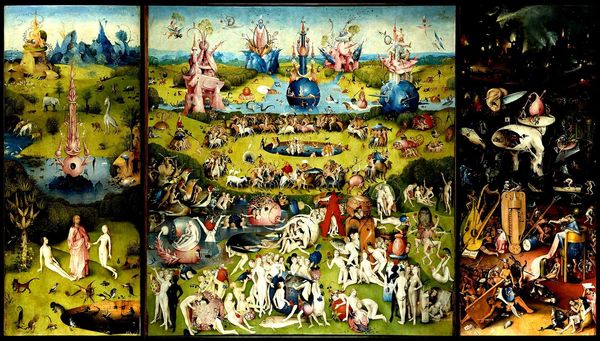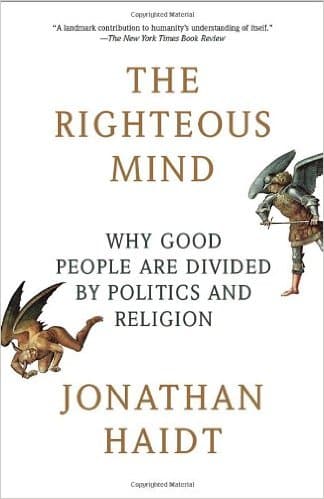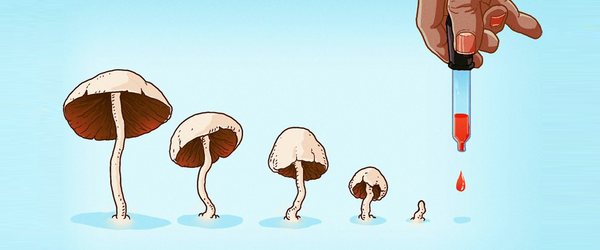Alex Moskov • • 15 min read
How Jonathan Haidt’s 6 Moral Tastebuds Can Heal a Divided World

It’s no secret that we live in a divided world.
For millennia, we humans have been splitting up into groups, distrusting groups we’re not part of, and fighting amongst ourselves. Our groups used to be nothing more than the tribes into which we were born, but nowadays, our groups are based on many things: politics, religion, class, race, sex, nationality, ethnicity, etc.
This tendency to split up into groups—sometimes called “tribalism”—is often harmless, but it can also become catastrophic if it gets out of hand. The 2016 US election and its aftermath is a recent example of extreme tribalism resulting in nasty consequences. People have become hyper-polarized, combative, distrustful, and violent toward one another. Close friends, family members, and neighbors are at each other’s throats. “We the people” are now thoroughly caught up in a seemingly unending, toxic game of “Us vs. Them.”
And the situation in the US is not isolated. It’s mirrored throughout the world in different ways. Tribalism is alive and well, and in many places, it’s leading to disaster. Given this situation, I find myself asking:
Is there a way out?
Perhaps. Perhaps—if I may be so audacious as to suggest—the way out of this mess has something to do with understanding and humility. Perhaps the answer to this riddle has something to do with admitting our own fallibility and probing deeper into the reasons why others see the world differently.
If this is indeed a promising course of action, there’s one man in particular who I think can be of tremendous assistance. His name is Jonathan Haidt.

Haidt is a moral psychologist who has spent the last two and half decades trying to understand why people are so divided by politics, religion, and questions of morality. HighExistence’s Executive Editor Jordan Bates wrote a fantastic introduction to Haidt’s work a couple months ago, and in this post I’d like to further expand on precisely what Haidt has discovered about human psychology and why it’s so damn important.
As I get into things, you might find yourself asking, “Wait, what does this have to do with healing division among people?” I ask that you trust me and bear with me; I swear to you that this man’s work is worth understanding.
Moral Foundations Theory

In his acclaimed book, The Righteous Mind: Why Good People are Divided by Politics and Religion, Jonathan Haidt summarizes his 25 years of research in moral psychology, evolutionary psychology, social psychology, and anthropology, and outlines an incredible theory that he helped to develop: Moral Foundations Theory.
Based on exhaustive research, Moral Foundations Theory holds that human morality is fundamentally based on six different moral foundations within the human mind.
Wait, what the hell are moral foundations?
I’m glad you asked. Moral foundations are basically innate psychological mechanisms for evaluating particular problems or situations. In The Righteous Mind, Haidt refers metaphorically to these mechanisms as “moral tastebuds.” Much like a tongue with six taste receptors, our brains have six major sensors which detect different “flavors” of moral data. If this doesn’t make sense just yet, keep reading; it will become clear.
Everyone has these six receptors, but through a combination of biological and cultural influences, different people end up with entirely different moral algorithms. That is, whereas one person might use all six receptors equally when forming moral judgments, another person might heavily favor two of the receptors and barely use the others. The vast majority of people don’t consciously choose which receptors to use—true choice in this regard may be impossible. These moral calculations happen rapidly, intuitively, near-unconsciously, and automatically.
As you might imagine, these differences in moral algorithms result in a human population with an incredible diversity of moral opinion. Once one understands these innate differences in how different people’s “moral tastebuds” function, one realizes that it makes perfect sense that people will be divided by questions of morality. Different people are using entirely different “moral tastebuds” to assess the same questions.
And that, my friends, is the essence of why people are so divided by politics, religion, and questions of morality. You might be thinking:
“Okay, so my [Republican or Democrat] Uncle Bill is using different ‘moral tastebuds’ to assess the same political questions, and that’s why he and I get along about as well as a mongoose and a king cobra. But what does that actually mean? What moral tastebuds is that man using? Surely they must be the dumb kind of moral tastebuds.”
Now, now, let’s not be too quick to judge. Everyone’s moral foundations exist within the same evolved operating system: the human mind. Given that natural selection groomed us to possess these particular moral foundations, we can reasonably assume that all of them were in some way integral to humanity’s success as a species.
The key is to stop assuming that the Uncle Bills within your world are “wrong” or “dumb” and to start asking, “What’s it like to be Uncle Bill? In what ways do his mind and my mind work differently?”
To help you understand the answers to these important questions and to see the significance of Moral Foundations Theory, I’m now going to explain the origin and purpose of each of the six “moral tastebuds.” I’ll also explain how each moral tastebud factors into the worldviews of political liberals (in the American sense of “liberal”) and political conservatives, so you can see plainly how different moral algorithms result in totally different ways of seeing the world. Everything up to this point has been pretty abstract, but hopefully these explanations will be more concrete and will clarify any questions you may have at this point.
The Care/Harm Foundation
The Care/Harm Foundation refers to the psychological machinery within human beings which prompts us to care about our fellow humans and try to help them avoid harm. This foundation evolved as a result of the vital importance of caring for vulnerable children. If a crying little girl tells you she lost her mom at Target, you’re naturally going to feel inclined to help her. This foundation makes us sensitive to signs of need and suffering, and it makes us despise cruelty.
Because of this foundation, we are triggered by things such as animal abuse, human rights violations, genocide, and poverty. Politically liberal people tend to heavily favor this moral foundation above all others. This tends to result in liberals having a more global perspective, expressing care and concern for all people and animals, regardless of national boundaries. Political conservatives also make serious use of this moral foundation, but they don’t favor it above all others. Thus, their Care/Harm Foundation tends to manifest as preferential care for their particular nation or group, with special care being afforded to those who have sacrificed for the group, such as wounded vets.
The Fairness/Cheating Foundation
The Fairness/Cheating Foundation refers to the psychological mechanisms which allow us to categorize actions as either “fair” or “unfair.” This foundation evolved as a result of humans forming reciprocal partnerships and benefitting greatly from well-functioning social contracts. We often act altruistically toward non-kin because we expect to receive “tit for tat” benefits. We want to form romantic and business partnerships with honorable people, and we want nothing to do with cheaters. This foundation is the bedrock of the popular understanding of or desire for karma. People want a society that punishes cheaters and rewards good citizens.
As with the Care/Harm Foundation, the Fairness/Cheating Foundation is integral in the worldviews of both political liberals (this is the other major foundation for liberals) and conservatives, though it manifests very differently, particularly in the domain of economics. Liberals are primarily concerned with the mega-wealthy “1%” cheating the system through loopholes and privilege, whereas conservatives are primarily concerned with people taking unfair advantage of the social safety net to live off of government benefits and the hard work of others.
The Loyalty/Betrayal Foundation
The Loyalty/Betrayal Foundation is our capacity to be loyal to certain people or groups and to feel distaste for traitors. For most of human history, tight-knit tribal groups were essential for our survival and prosperity, and so this foundation evolved to facilitate the formation of long-term, tightly bonded groups. Nowadays, we still form tribes, though they’re based on a much wider range of things, such as nationality, religion, sports teams, dietary choices, and much more.
The tribal instinct was and still often is a powerful force for human flourishing. This instinct allows a group of human individuals to become more than the sum of its parts. A group’s power and longevity rely heavily on its cohesiveness. Loyalty is what kept us together as tribes, and it continues to keep us together on a much larger scale as citizens. However, when taken to the extreme, tribal loyalty can have disastrous consequences, resulting in warring factions willing to use violence to assert dominance over other tribes. Tribalism, in fact, is one of the main phenomena underlying much of the division over politics and religion that we see in the world today.
Our propensity for loyalty is balanced by a deep disdain for treachery, since a single traitor could undermine an entire system. Dante’s Inferno puts traitors in the innermost circle of hell, a far more agonizing locale than that of lust, gluttony, violence, and even heresy.
The Loyalty/Betrayal Foundation is one of the primary points of division between political liberals and conservatives. For conservatives, the Loyalty/Betrayal Foundation is typically given about as much weight as each of the other five moral foundations. As such, conservatives have historically been willing to accept war and a more aggressive foreign policy if it protects the United States. Liberals tend to favor the Care/Harm Foundation much more than the Loyalty/Betrayal Foundation, and thus tend to be in favor of a pacifistic, global-minded foreign policy.
The Authority/Subversion Foundation
The Authority/Subversion Foundation refers to our capacity to appoint members of our groups to positions of power for the benefit of all, as well as our tendency to feel threatened by those who disrupt the status quo distribution of power. For most of human history, authority was not power for power’s sake; rather, it was responsibility—power bestowed for the purpose of performing socially beneficial functions. Ultimately, having honorable, responsible people in positions of power benefits everyone, so we evolved a tendency to revere authority.
This is why we are responsive to signs of rank or status—to uphold the hierarchical structure that (ideally) inevitably benefits us. Think about a mailman slapping the President of the United States. Liberal or conservative, you’re likely to wince internally upon considering such a scenario. This wincing is your Authority/Subversion Foundation being activated.
Again, this foundation manifests quite differently nowadays for conservatives and liberals. Conservatives tend to have more trust in traditional hierarchies and authority figures. Liberals tend not to prioritize the Authority/Subversion Foundation as highly as the Care/Harm Foundation and Fairness/Cheating Foundation, so they’re generally less concerned about matters of authority and are also more likely to be subversives. Liberals also often respect moral authority figures whose power derives not from holding an elected office or high-status societal position but from intrinsic force of character (think Gandhi or MLK Jr.).
The Sanctity/Degradation Foundation
The Sanctity/Degradation Foundation refers to our capacity to understand things as being “sacred” or “pure” and to feel a deep aversion to those things being “disrespected” or “desecrated.”
The evolutionary roots of this foundation arose from the necessity of keeping oneself and one’s family free of pathogens and parasites. Our early ancestors were faced with the omnivore’s dilemma of needing to seek out new potential foods without knowing exactly what was poisonous and what was harmless. This dilemma is believed to have resulted in the human population dividing into two groups—those characterized by “neophilia,” an attraction to novelty, and “neophobia,” an aversion to novelty. It was evolutionarily beneficial to have some of the population open to trying new things, while having others who were closed off to novelty. Those open to novelty could discover new foods, while those closed off would ensure the safety of the overall population by not taking dangerous risks.
This divide between those who are open to new experiences and those who are closed off to them persists to this day. Fascinatingly, Jonathan Haidt’s research has shown that it’s possible to predict whether someone is liberal or conservative based on whether they have a high or low degree of openness to experience (liberals = high; conservatives = low), one of the Big Five personality traits. Research has also suggested that openness to experience has a genetic component (as the evolutionary model would suggest), meaning that a person’s level of openness may be largely determined before they are born. If you’ve jumped ahead in the line of reasoning, you’ve already realized the startling conclusion:
People’s political orientation may be largely predetermined before they’re born.
Haidt’s research on openness to experience isn’t the only research that has suggested this. A number of other studies have suggested a link between biology and political orientation.
But anyway, I’ve digressed a bit. As I was saying, the Sanctity/Degradation Foundation arose from an evolutionary division between those who were open to new experiences and those who were not. Initially, this openness/closed-off-ness functioned only in the domain of sensory experience, but over time, it morphed into collective cultural tendencies to be open in certain areas and closed off in other areas—to view some cultural institutions/traditions as mutable and others as untouchable, pure, sacred. This is why some cultures are welcoming to immigrants and outside influences, while others are highly xenophobic and closed off.
The Sanctity/Degradation Foundation allows cultures to mark certain things as untouchably sacred. Think of crosses, flags, Mecca, grave sites, and even principles like equality, liberty, and democracy. Most Americans would cringe at the sight of our flag being burned, yet wouldn’t think twice of a different cloth pattern being publicly torched. Once the Sanctity/Degradation Foundation morphs and transfers into the domains of ideology and religion, things get pretty intense. Radical jihadist groups such as ISIS are, in part, radicalized and ready to commit atrocities because they feel the West has disrespected and disregarded many of the ideas and principles they hold to be Absolute and Sacred.
As you can imagine, this foundation manifests very differently for liberals and conservatives in the modern world. Conservatives value things like the “sanctity of marriage” or the “sanctity of life” not because they want to control individuals, but because they believe they’re protecting the bedrock of their moral community. Liberals, of course, tend to view these traditional conservative virtues with disdain, to see them as sexist and old-fashioned. But liberals are not immune to the effects of this foundation either. For liberals, the environment is sacred and must be protected from pollution and other degradation; additionally, the body is sacred and must be purified through vegan, organic, or other (sometimes irrational) dietary choices. The Sanctity/Degradation Foundation is fascinating: an impulse to avoid disease, born out of the behavioral immune system, has evolved into a psychological mechanism which causes people to adopt extreme and sometimes irrational values to protect themselves and keep their groups together.
The Liberty/Oppression Foundation
The Liberty/Oppression Foundation is the human tendency to desire freedom and to be averse to oppression. Haidt suggests that this tendency traces its roots back to the rise of agriculture about 10,000 years ago, when humans became more sedentary. Private property came into existence, because humans were now able to own more than they could carry with them wherever they went. This soon resulted in some individuals seeking to gain more than others through whatever means possible, many of which were dishonest, malicious, or deprived certain helpless people of equal opportunities, limiting their freedoms. Since that time, most human societies have witnessed an ongoing struggle between those who fight for equal opportunity for all people and those who try to establish an uneven playing field for their own gain.
Anthropologist Christopher Boehm has likened oppressors to alpha male chimpanzees that took advantage of their authority and became bullies who took what they wanted, rather than responsible overseers performing socially beneficial functions. Occasionally, subordinate chimpanzees would join forces to take down the alpha males, sometimes killing them in the process; in the same way, oppressed humans will occasionally rise up to overthrow and/or murder their oppressors.
With the invention of weapons some 64,000 years ago, the balance of power within human groups shifted and defied what had been the primate norm for millions of years. Suddenly, a weak human with a spear could take down a tyrannical alpha. Throw in the advent of language, which allowed humans to communicate and gossip about violations of the social order, and suddenly you had communities in which those at the bottom of the social hierarchy were more empowered than ever to prevent abuses of power. This gave rise to “reverse dominant hierarchies,” in which the mass of people at the bottom prevent those at the top from becoming abusively dominant. For this reason, most human groups prior to the advent of agriculture are believed to have been largely egalitarian.
With the advent of agriculture, though, complex societies and civilizations began to arise, in which there were more elaborate mechanisms in place to facilitate societal functioning and therefore more potential entrance points for a malicious actor to leverage the system dishonestly for their own gain. Furthermore, the division of labor that came shortly after the advent of agriculture gave rise to systems of class, which were quite conducive to the idea that some members of a society were simply meant to be less important and valuable than others. Thus, since the advent of agriculture, inequality of opportunity has been the norm in human societies, with equality of opportunity (or at least something close to it) only arising as the exception (e.g. in some Western countries in the last ~50-100 years).
Despite the fact that real equality of opportunity is the exception, humans still tend to refuse to allow themselves to be overtly and violently subjugated. Dominators and tyrants trigger the Liberty/Oppression Foundation, and humans tend to unite to overcome or destroy the oppressor. According to Haidt, there’s an ideal middle ground between the extremes of the Authority/Liberty Foundation in which we trust authority (as this is necessary to some extent for the functioning of complex societies), but are very vigilant for traces of tyranny or corruption.
The ways in which this foundation manifests in the modern political landscape are quite fascinating. Libertarians tend to esteem this foundation above all others, placing absolute value on maximizing individual liberty. Conservatives tend to view high taxes, strict business regulations, and sovereignty-reducing globalist policies as oppressive because they reduce individual liberty. This is why many libertarians tend to vote Republican—they see eye to eye on this point.
For liberals, the Liberty/Oppression Foundation manifests as an overpowering desire to protect and liberate any special interest groups who may be somehow disadvantaged by the current social order. Unlike conservatives, liberals are much more willing to limit the freedoms of other people in a society in order to increase services and benefits for the less fortunate.
Conclusion: Overcoming Tribalism
Tribalism—”a way of thinking or behaving in which people are (excessively) loyal to their own tribe or social group”—is deep-rooted in human communities. In our long history, most lone wolves barely had the capacity to survive, let alone take care of offspring. We are largely the offspring of ancestors that successfully formed tribes that were able to leverage the strength of the community to survive. Statistically, the more cohesive a tribe was the more likely it was to make use of scarce resources and fend off threats.
We owe our existence today to the human capacity for tribalism, but at extreme levels tribalism gets nasty. People start to place an absolute faith in their tribe that puts them at odds with any other tribes. If their trust in their tribe is absolute, people become willing to commit atrocities to uphold or enforce its values. Political polarization happens when people start to pledge loyalty to their parties even in the face of new, contradicting information. People at the political right and left extremes also tend to be extremely vocal, and these tribe leaders make it seem that the vastly larger middle only has two options.
Much of the conflict and issues faced by humanity arise from our inability to let go of tribalism and to see the common ground in our morality. By understanding the roots of opposing views in politics, religion, and other domains, we can start to have constructive conversations about subjects that are considered taboo. We can realize that it’s entirely possible for good people to see the world in entirely different ways. We can break out of the emotional and tribal gridlock that makes it so difficult for us to find workable solutions to social, economic, and global issues.
2,000+ years ago, Jesus Christ said, “A house divided against itself cannot stand.” Although we’ve progressed quite far in many ways, humanity itself yet seems to be a house divided, and eventually, we will no longer be able to stand, if we cannot heal our divisions. Moral Foundations Theory and Haidt’s work offer us a way out—a way of understanding the deep biological and cultural reasons why we are divided in order to transcend shallow, reactive tribalism. I humbly submit that every human in the world would do well to read The Righteous Mind and take its ideas to heart. Our future may depend on our collective ability to understand the lessons it contains.
———
Many thanks to Jordan Bates, who helped me to co-author this essay.
Further Study
- Again, I highly recommend reading Haidt’s book, The Righteous Mind. You can grab it on Amazon or read the key insights for free on Blinkist.
- You can read Chapter 7 of The Righteous Mind—the chapter on Moral Foundations theory—for free online here.
- Haidt’s TED Talk on the moral foundations of liberals and conservatives is fantastic
- Here’s a great interview Jonathan Haidt did with Bill Moyers that makes a great follow-up to his TED Talk
- Haidt’s talk called ‘Three Stories About Capitalism’ is an amazing attempt to understand both sides of the fierce debate over capitalism and to synthesize the two main stories about capitalism










